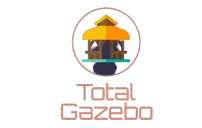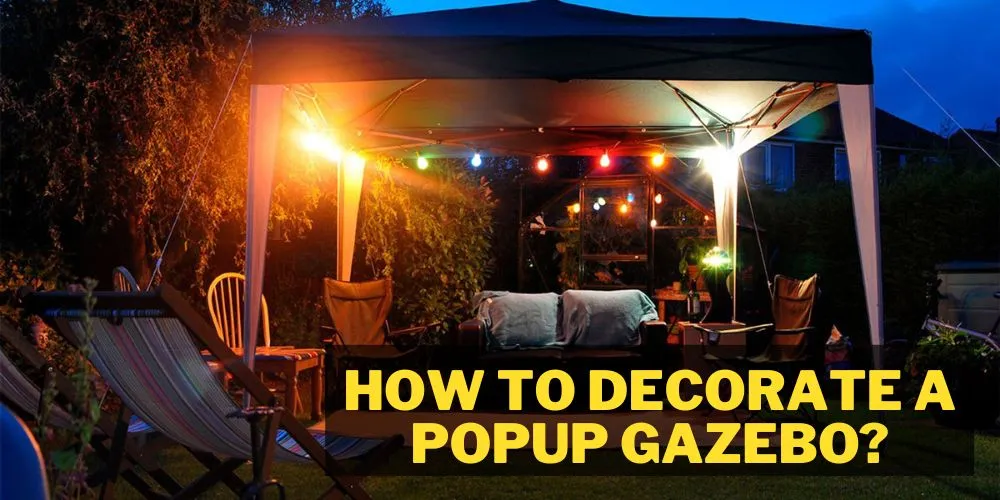Experiences such as camping are often rebranded as glamping. That doesn’t always have to be a bad thing, though. However, these gizmos and gadgets require electricity to function.
So, can you run electricity to a gazebo?
The answer is yes, you can run electricity to a gazebo, but there are some requirements and considerations you should be aware of which I will explain here in this page.
Running power to your gazebo can assist in adding things such as music, lighting, cold food, cooking facilities, and various screens.
In this article, I’ll go through the simplest ways to get a power source to your gazebo so you can enjoy your home away from home.
Can you run electricity to a gazebo?
It’s possible to run electricity to a gazebo. However, the method by it is installed will be determined by the type of gazebo that requires it. For example, hardtop gazebos are generally semi permanent structures.
Therefore the power outlet, cables, and connection point can be hard wired.
The same method would apply when powering up a permanently built gazebo. A popup gazebo used on occasions such as camping trips, sports events, or BBQs may only need an extension cable run from a general power outlet for the length of the occasion or event.
Understanding Requirements and Safety Considerations
Before installing electricity to your gazebo, it’s important to understand the requirements and safety considerations involved. The National Electrical Code (NEC) provides guidelines for installing electrical wiring, and it’s important to follow these guidelines to ensure that your gazebo remains safe.
One of the primary requirements you should consider is choosing the right gauge wire for your extension cord or wiring. Choosing the right gauge wire ensures that you have the right wire size for the voltage and amperage you’ll be using. If you are unsure about the wire size, consult a licensed electrician in your area.
Another important consideration is to determine the power requirements for your gazebo. Consider the lights, ceiling fans, TVs, and other electrical appliances you might want to use in the gazebo, and ensure that you have enough power to support them.
It’s also important to consider factors like voltage and amperage requirements, as well as the power source available.
Safety Precautions and Considerations
Once you have determined the power requirements for your gazebo, you need to think about safety considerations. Your safety is paramount when it comes to handling any electrical work. Here are some safety precautions to keep in mind:
- Turn off the power: Always turn off the power when working with electricity. This means shutting off the breaker at the main electrical panel.
- Inspect for damage: Check all wires, cords, and extensions for damage before installation. Replace anything that’s frayed or broken.
- Use GFCI outlets: Ground-Fault Circuit Interrupter (GFCI) outlets help to prevent electrical shocks. They should always be a part of your electrical circuit when wiring a gazebo.
- Waterproofing: All outdoor electrical outlets and wiring should be waterproofed to prevent electrocution or system damage from water exposure.
- Dig safely: When burying conduit or cords, make sure to call your local utility company to get the necessary information on underground safety procedures.
How to run electricity to a gazebo?
Adding a power source to your gazebo can be a real game changer. The type of gazebo you have will determine how you set up access to electricity. In some cases, the cables can be permanently installed underground to prevent trip hazards or issues with extreme weather, etc.
Otherwise, a simple good quality extension cable can be connected to a power outlet for spontaneous events. Let’s have a look at all the things to think about and consider when adding a source of power to a gazebo.
1. Determine the exact location
Planning is essential when dealing with electricity and ensures that no headaches pop up later down the track. One of the first actions to be taken is determining where you wish to build or install your gazebo. Pop up gazebos require much less effort in this area, as you can usually be pretty flexible with connecting an extension cable to the power source.
However, permanent and semi permanent variants need to be seriously considered. You may require the cables to be run underground through a conduit. In doing so, you only want to dig a trench once, so ascertaining the location of the gazebo is vital. Once the conduit is underground, the cable can usually be pulled through freely.
2. Choose proper electrical wiring and circuit breaker
Once you know where you want to run your cabling, you will need to go out and gather the supplies needed for the job. It’s always recommended to consult with a qualified and licensed electrician or supplier when purchasing electrical supplies. Not only could you be breaking the law by using the wrong materials, but it could also be extremely dangerous.
The key points to consider here are where your power source comes from, running that power source to your desired location, and an outlet that is safe to use in the environment where it will be installed. Additionally, a circuit breaker must be installed or utilized at the power source.
3. Install a weatherproof outlet
Given that gazebo are generally built or erected outside, they need a weatherproof power outlet. The last thing you want is for the circuit breaker to constantly trip due to water, wind, or snow damage.
Having these outlets installed somewhere off the ground and undercover is always best. It can even be worth building a box around it that can be locked up for when it’s not in use. Make sure to consult with a professional regarding any electrical work or alterations, though, as messing with power can be fatal.
4. Install a circuit breaker
Circuit breakers cut the power supply (break the circuit of power) if some kind of mishap occurs when the power is in use. It can be affected by water; it can overload if you attempt to use something that tries to suck more power out than the outlets can produce, or it can even catch on fire. Circuit breakers are a must! Installing one of these should be done by a professional electrician.
5. Run the wiring from the house to the gazebo
Depending on the gazebo’s location and wiring methodring, you would generally run the cable from your house to the location of the gazebo. This can be done by digging 1-2 feet into the ground and laying a conduit pipe first. Once in place, you can feed the cable through the pipe and leave each end of the cable sticking out.
Leave a good 1-2 meters of extra cable if the lengths need to be altered. Connect or hard wire the gazebo end, then fill the conduit trench back up. Have the power source end connected. The power MUST be temporarily switched off while connecting.
Honestly, with 20 years of experience in the construction industry, I still wouldn’t go anywhere near cable work by myself, so I highly recommend a qualified and licensed electrician to help with the connection.
Additional Tips and Precautions
As handy as having a power source in your gazebo, there are a few minor points worth noting to ensure anything installed is completely safe for both the gazebo and its users. Let’s have a look at some tips and precautions that can often be overlooked:
Hire a licensed electrician for the job
Nothing should be completed based on guesswork when it comes to anything electrical. We cannot stress this enough. All it takes is one wrong move, and there could be dire consequences. Always consult a licensed and qualified electrician to help you with the work. They will walk you through planning until the final signoff.
It may be that you complete anything labor intensive such as installing the power outlets without connecting them or even digging the trench and laying the cable. The final fit off should always be done by a professional. They have all the tools to check that the power is running as it should.
Furthermore, they will sign off on the job so that you can be sure that everything has been checked over for safety. Lastly, you won’t be liable for any damages if a professional has signed off on the project.
Use outdoor-rated electrical equipment and materials
99% of gazebos are built or installed outdoors as their purpose is to provide outdoor shelter. With this in mind, using outdoor-rated electrical equipment and materials is a must! These supplies are usually built with extra protective parts to help mitigate leakage and overheating.
They may have fold up cover plates or specialized waterproof outlets to help minimize any accidents caused by unfavorable weather. Some supplies can even be rated for extreme heating, ideal around bbqs or roof areas where heat may be an issue.
Consider installing a ground fault circuit interrupter (GFCI) for added safety
GFCI’s are installed into the actual power outlet as opposed to general circuit breakers (fuses), which are installed in a power board. Consequently, fuses are designed to protect equipment, whereas CFGI’s are designed to protect people. These pieces of equipment since the amount of power being used and can cut off the power source if a dangerous amount is pulled.
Furthermore, they can also sense if a cable of outlet becomes water damaged and stop the power instantly as a result. They are usually installed in wet areas of a home, such as kitchens, bathrooms, laundry areas, etc. Installing a CFGI within your newly wired gazebo is a must these days, especially when the chance of them getting wet or overheated is high.
Frequently Asked Questions (FAQs)
Do I need permission to put electricity in my gazebo?
It’s always recommended to check with your local council when planning to add electricity to your gazebo. It’s not always guaranteed that you’re allowed to do so. Some governing bodies require permits to be signed off on so that they have a record of the works. This permit serves as information for future purposes. They may want to build in an area later on and have the added cables documented.
Can I run an extension cord to my gazebo?
It’s always best to check with a licensed and qualified electrician when it comes to running any kind of cable work. In general, though, you can usually run an extension cable from a power supply to your gazebo on a temporary basis as long as the equipment that you use doesn’t use more power than the outlet supplies. Otherwise, the fuse will just keep tripping.
Can I use solar energy to power my gazebo?
Yes, you can use solar energy as an alternative to traditional power sources. There are different types of solar panels, so it’s important to choose the one that best suits your gazebo and power requirements.
Conclusion:
Running electricity to a gazebo can provide convenience and added functionality to any outdoor space. It is important to carefully plan and safely execute the project to avoid any potential hazards.
The best way to ensure safety is by consulting with a licensed and qualified professional to help plan, complete, and sign off on the work. We hope that this guide regarding can you run electricity to a gazebo has been helpful. You can read about similar topics here on our website. Check back again soon for more.

